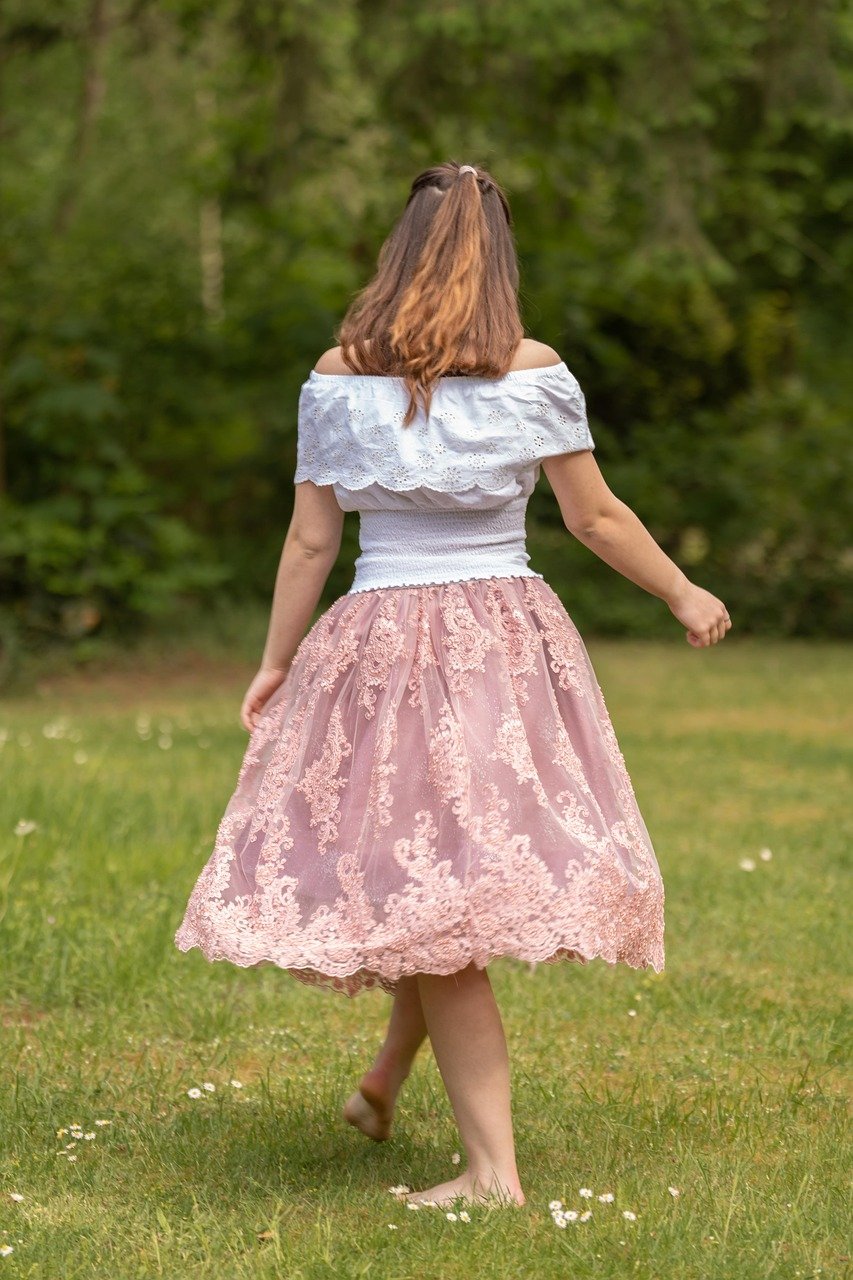There’s something inexplicably calming about walking barefoot on soft grass. The sensation triggers joy, peace, and connection—feelings that are increasingly rare in our modern, technology-driven lives. But did you know there’s science behind this simple pleasure?
This practice, often referred to as grounding or earthing, is so much more than just a barefoot stroll through nature. It’s a holistic method of restoring balance and promoting well-being by physically connecting with the Earth’s natural energy.
This blog explores the history, benefits, and practical techniques of grounding. From its historical roots to the modern scientific research behind it, we’ll uncover why spending just a few minutes barefoot on grass could have profound implications for your health.
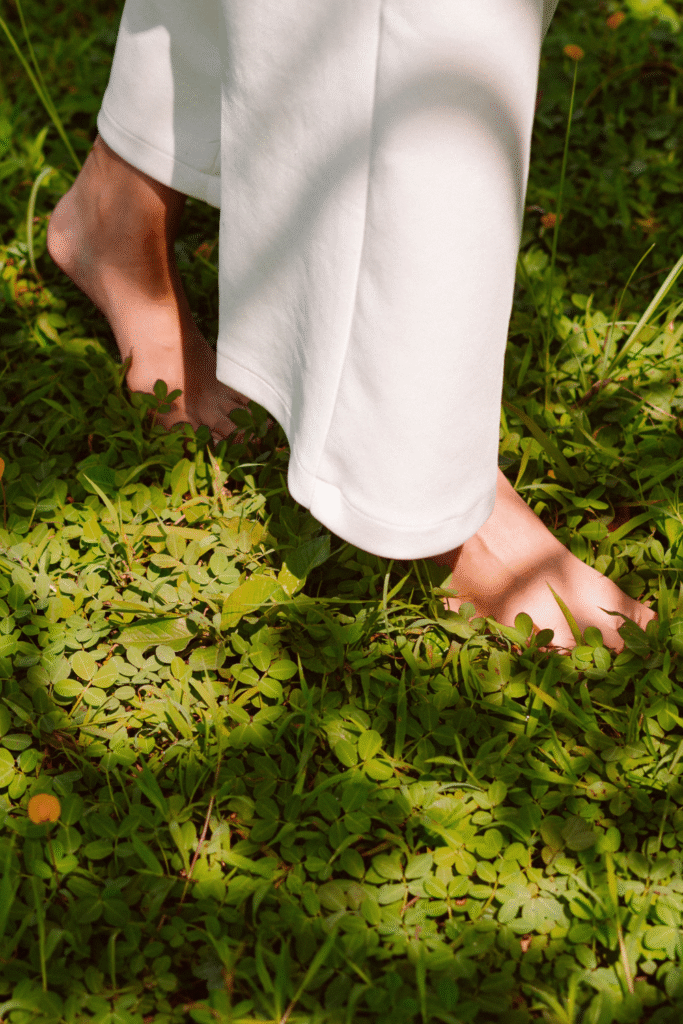
What Is Grounding?
At its core, grounding refers to direct physical contact with the Earth’s surface, such as walking barefoot on grass, soil, or sand. This simple act allows you to absorb the Earth’s electrons, which are believed to have various health benefits.
The Earth generates a natural electric frequency that our bodies may respond to. By connecting with it, you create a pathway for these electrons to flow into your body, potentially helping to neutralize harmful free radicals and inflammation.
It’s worth noting that grounding isn’t limited to walking barefoot. Other techniques include lying down on natural surfaces, wading in natural water bodies, or using grounding mats indoors. However, walking barefoot remains the most accessible and natural method.
The Science Behind Grounding
The concept of grounding isn’t just spiritual or anecdotal—it’s rooted in scientific research. Studies have shown that grounding can influence the body’s electrical activity and reduce biomarkers of stress and inflammation.
One of the key mechanisms is thought to be the Earth’s abundant supply of free electrons. When you come into contact with the Earth, these electrons enter your body and act as antioxidants, neutralizing free radicals, which cause oxidative stress and aging.
Emerging research also suggests a connection between grounding and improved heart rate variability, blood viscosity, and even better sleep. These findings point toward grounding as a promising, drug-free way to address mental and physical challenges many people face today.
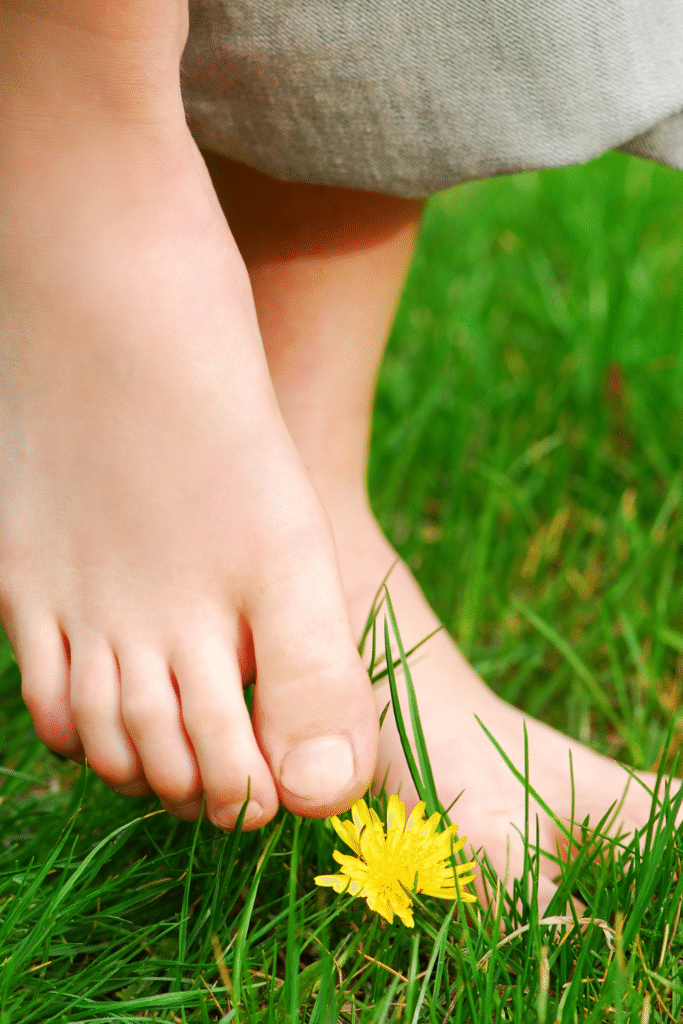
The History of Grounding
The practice of connecting with the Earth through grounding has deep historical roots. Traditional cultures and indigenous communities worldwide have long advocated for the healing power of nature. Before the advent of synthetic footwear and urban living, humans inherently maintained close contact with the Earth daily.
Ancient Practices
People in ancient times spent much of their lives barefoot or wearing minimal leather footwear that conducted the Earth’s energy. Many cultures viewed the Earth as a life force—a source of physical and spiritual nourishment. Practices like earthing were not just habits but deeply ingrained traditions. For example:
- Native American Tribes: Many tribes performed rituals and dances barefoot as a way to honor and connect with the land.
- Eastern Medicine: Practices like Tai Chi and Qigong highlight the importance of energy flow and grounding the body with nature’s energy.
Modern Rediscovery
The industrial era and the subsequent rise of synthetic materials in shoes have significantly disconnected humans from their natural environment. It wasn’t until the late 20th century that grounding began to resurface as a scientifically-backed practice, largely thanks to pioneers like Clint Ober, who introduced the concept of earthing to a broader audience.
Today, the practice is gaining mainstream attention, not just in wellness communities but also among medical professionals intrigued by its therapeutic potential.

How Walking Barefoot on Grass Grounds You
The simple act of walking barefoot on grass exposes your body to the Earth’s energy fields. Here’s how it works:
- Direct Contact
When your skin comes into contact with the ground, it establishes an electrical connection with the Earth. The soles of your feet, rich in nerve endings and sweat glands, serve as conductive pathways for the Earth’s natural electrons.
- Electrical Neutralization
These electrons neutralize the body’s excess positive charge caused by exposure to electronics, pollution, and other sources of electromagnetic fields (EMFs).
- Health Alignment
With regular grounding, you may notice a shift in your overall energy balance, which can support cellular functions and bodily processes.
Walking barefoot in grassy areas adds a sensory aspect, too, as the texture, temperature, and even scents from nature contribute to relaxation and mindfulness.
Choosing the Right Setting
Maximizing the benefits of grounding requires choosing the right environment. Shoes off, toes in the grass—it’s that simple, but here’s what matters most when selecting your grounding spot:
- Moist Grass: Wet or dew-covered grass enhances conductivity for a stronger grounding effect.
- Natural Areas: Parks, forests, and gardens are ideal spaces free from artificial interference.
- Free From Chemicals: Steer clear of grass treated with synthetic fertilizers or pesticides.
By consciously creating opportunities to connect with these natural spaces, you can enrich both body and soul.
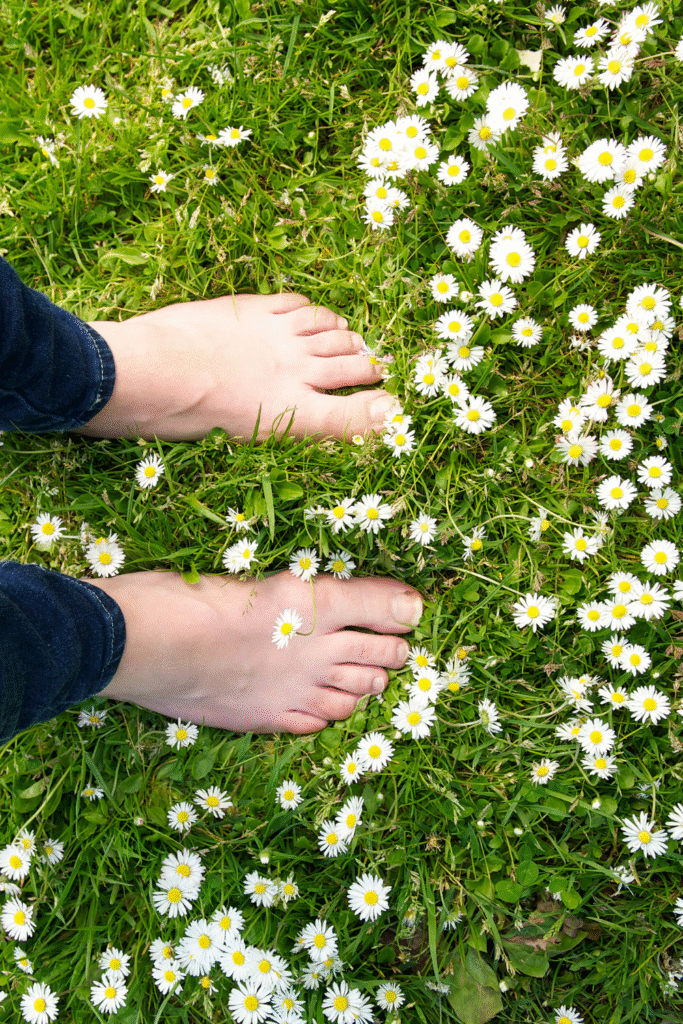
The Benefits of Grounding
Walking barefoot on grass isn’t just relaxing—it may provide a host of substantive benefits for physical and mental health. Below, we outline some of the most compelling benefits of grounding supported by research and anecdotal evidence.
Physical Health Benefits
- Reduces Inflammation
Chronic inflammation is linked to many diseases, including heart disease and arthritis. Grounding may help decrease markers of inflammation by neutralizing oxidative stress caused by free radicals.
- Enhances Sleep Quality
People who ground themselves report feeling more relaxed and experiencing deeper, more restorative sleep. This could be due to the cortisol-regulating effects of grounding, which help synchronize circadian rhythms.
- Improves Circulation
By reducing blood viscosity, grounding promotes better blood flow, which can positively impact cardiovascular health.
- Boosts Immune Function
Some studies suggest that regular exposure to the Earth’s electric field may strengthen immune system functions, keeping common illnesses at bay.
Mental Health Benefits
- Reduces Stress and Anxiety
The calming act of reconnecting to the Earth slows down your mind and reduces stress hormones like cortisol, promoting a state of calm and mindfulness.
- Enhances Mood
Grounding triggers a sense of euphoria and boosts energy levels, helping you feel more optimistic and present.
- Encourages Mindfulness
Being barefoot in nature encourages you to stay present at the moment, focusing on tactile sensations and letting go of mental clutter.
A Boost for Overall Well-being
Collectively, these physical and mental benefits promote holistic wellness. By integrating grounding into your routine, you’ll find a balance that nurtures both your body and mind.
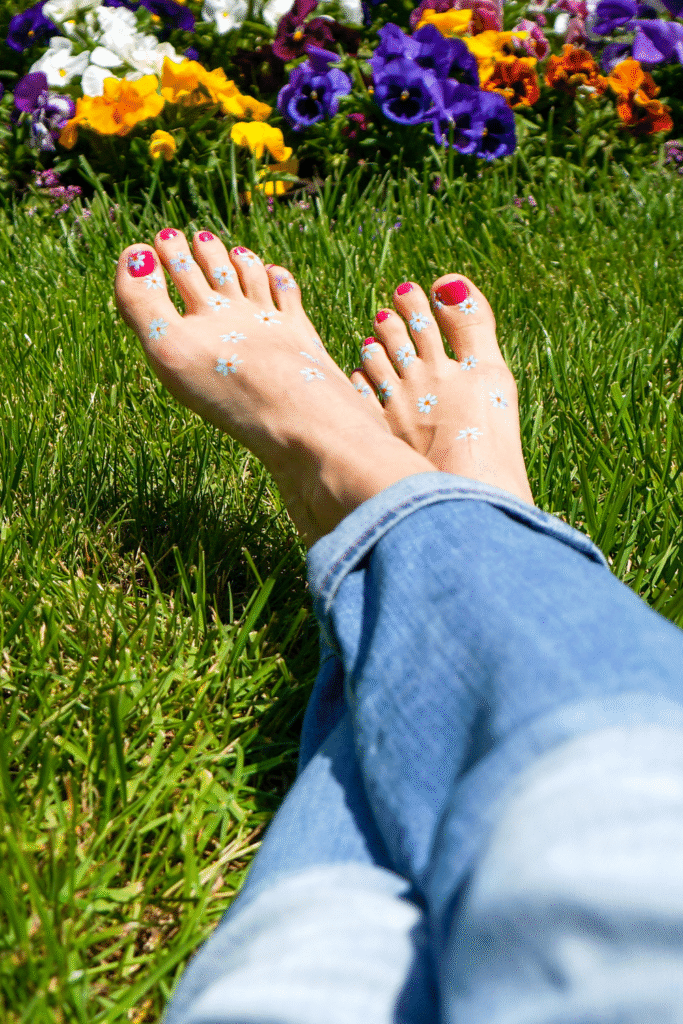
Practical Earthing Techniques Beyond Grass Walking
While walking barefoot on grass is an excellent way to ground yourself, you can integrate other grounding techniques into your lifestyle for maximum benefits:
- Beach Grounding: Spending time barefoot on sandy beaches combines grounding with the therapeutic sound of waves.
- Water Grounding: Wading through rivers, lakes, or the ocean naturally grounds your body through direct contact with water.
- Lying on Soil: Resting directly on the ground during picnics or yoga sessions enhances your connection to the Earth.
For those spending more time indoors, grounding mats, earthing sheets, and other conductive equipment mimic the grounding effect for urban dwellers.

Getting Started with Grounding
Achieving the benefits of grounding doesn’t require massive time commitments or close proximity to rural nature. Start small, even with a 10-15 minute walk in your local park. Here’s a beginner-friendly routine anyone can try:
- Head to a patch of untouched grass, such as a park or your backyard.
- Remove your shoes and allow your feet to sink into the grass.
- Spend five minutes feeling the texture and temperature underfoot.
- Focus on your breathing—inhale slowly and exhale fully while observing your surroundings.
- Gradually increase your grounding time as it becomes a natural part of your daily wellness routine.
Tips for Busy Lives:
If you struggle to find time outdoors, try to incorporate grounding into your existing activities. For instance, enjoy your morning coffee barefoot in your garden, or practice yoga in the park.
These small moments of connection to nature can add up in profound ways.
Reconnect with Nature, Reconnect with Yourself
Grounding is more than a wellness trend—it’s a timeless practice that invites you to slow down, shed artificial disconnection, and rediscover your bond with the Earth. By walking barefoot on grass, you can tap into the healing power of nature and find harmony in body, mind and spirit.
Start small—spend a few minutes each day connecting with the earth in a way that feels natural to you. Whether it’s a leisurely stroll on the beach, tending to your garden, or simply sitting under a tree, make it a daily ritual to immerse yourself in the outdoors.
Over time, these moments of grounding can lead to reduced stress, improved energy, and a deeper appreciation for the world around you. Reclaim your connection to nature and experience the profound sense of peace it can bring.
Join the Conversation
What are your thoughts on grounding? Have you tried connecting with the Earth in this way? Share your experiences and insights in the comments—your perspective could inspire someone else to try it!
